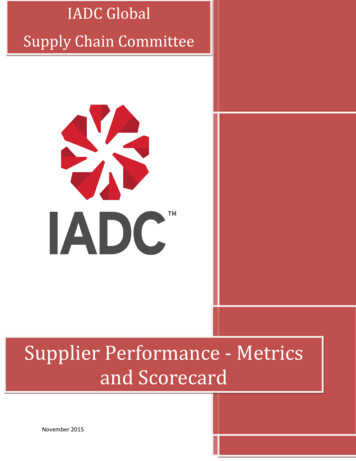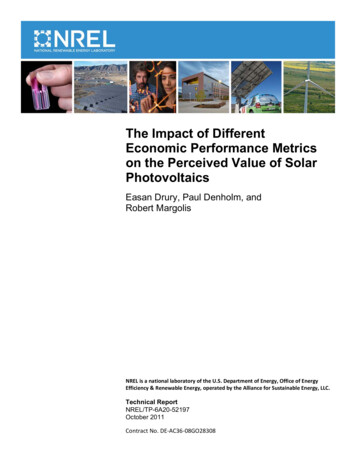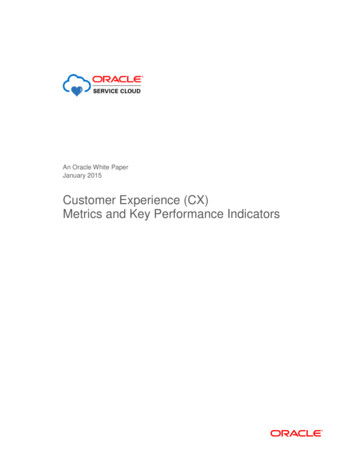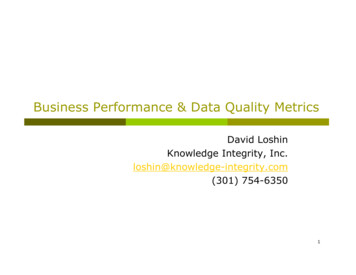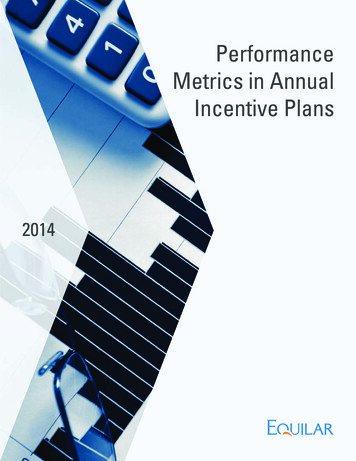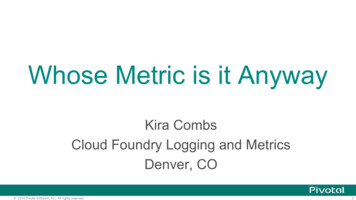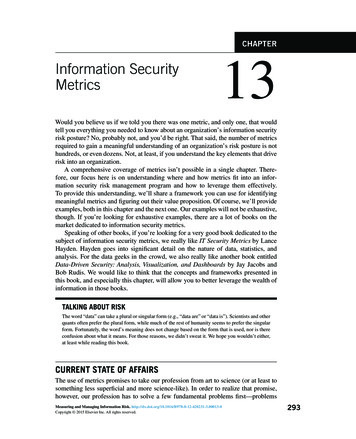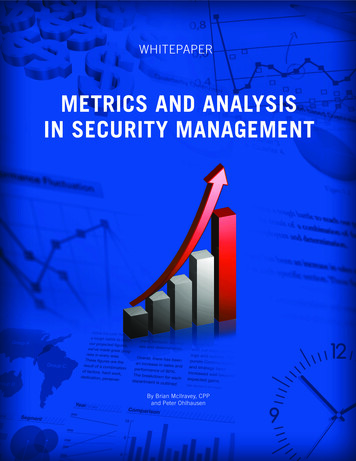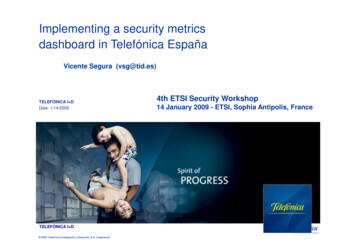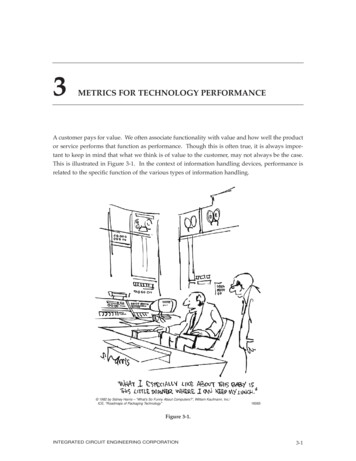
Transcription
3METRICS FOR TECHNOLOGY PERFORMANCEA customer pays for value. We often associate functionality with value and how well the productor service performs that function as performance. Though this is often true, it is always important to keep in mind that what we think is of value to the customer, may not always be the case.This is illustrated in Figure 3-1. In the context of information handling devices, performance isrelated to the specific function of the various types of information handling. 1982 by Sidney Harris – “What’s So Funny About Computers?”, William Kaufmann, Inc./ICE, "Roadmaps of Packaging Technology"16065Figure 3-1.INTEGRATED CIRCUIT ENGINEERING CORPORATION3-1
Metrics for Technology PerformanceINFORMATION HANDLING TECHNOLOGIESOur society has always had a thirst for information, and technology has been fueling the revolution in how we access information since the Gutenberg press first churned out 42 line Bibles in1454. Information is handled in four basic ways: processed transmitted stored interfaced with the physical worldEvery task performed by every electronic device fits into one of these four tasks. Figure 3-2 listsexamples of each of these activities. Computers, communications and consumer products arehuge markets for information handling.Information ProcessingData compressionImage morphingDatabase searchingTranslationInformation TransmissionTelephone transmission over twisted pairTV transmission over radio wavesPDA to PC over IR linkIDE controller to hard drive over SCSI busInformation StorageFloppy driveHard driveCDMagnetic tapeInformation InterfaceCRT monitorKeyboardMouseSpeakersSource: ICE, "Roadmaps of Packaging Technology"22164Figure 3-2. Four Information OperationsInformation processing is the transformation of data into information. This is a pervasive taskwhich happens in virtually all electronic systems from supercomputers to digital watches embedded in pens or rings. It only takes a few gates to process information, and when a 4-bit embedded microcontroller costs 25 in high volume, it is only a matter of time before any device withaccess to a battery or is plugged in the wall will be capable of information processing.3-2INTEGRATED CIRCUIT ENGINEERING CORPORATION
Metrics for Technology PerformanceInformation transmission is the transport of data from one location to another. Every electronicinterconnect interface is devoted to either power or information transmission. This task spans fromtransistor to transistor on a chip in 2 micron long fine line aluminum wires, to 45 kilometer longfiber-optic cables from repeater to repeater station, two miles deep in the Atlantic Ocean. In a scaleappropriate to our human size, we are touched by information transmission on a daily basis overtelephone lines, by electromagnetic waves to radios and by infrared links from our remote controlto a TV.Information storage is the placement of data in a static media where it can be located and retrievedat a later time. This task spans the scale from on chip registers that may be only 16 bits wide,through optical disk farms that may contain 10,000 CD discs, each with 10Gbits of data. There arethree currently used electronic media for information storage: semiconductorÑin various formsof random access memory (RAM), such as dynamic (DRAM), static (SRAM), video (VRAM), flash,etc.; magnetic, such as magnetic tape, floppy disks and hard disks; and optical, such as compactdisks (CDs), and digital video disks (DVDs).Information interface refers to the transfer of information from the physical world to the electronic world, either as input or as output. The Man-Machine interface is a specialized case. Themost common output interfaces encompass visual display devices such as CRT (cathode raytube), LCD (liquid crystal display) and printers, or sound generation through speakers. Vibrationis also popular as an output for pagers, transmitting one bit of information. The most popularinput devices today are keyboards, mice, pen-touch screens and microphones for use with voicerecognition software. In addition to the Man-Machine interfaces, there is a whole universe of sensors and actuators that are used in monitor and control applications for automotive, home andindustrial environments.Though only information processing and transmission are discussed below, the packaging technologies used in all four applications are discussed throughout this book.INFORMATION PROCESSINGThe Migration from Super Computer to Shirt PocketThere has never been, and will never be, enough processing power available to the individual.The functions performed by super computers today will eventually be performed by personalcomputers and PDAs tomorrow. Those functions only dreamed of now, will some day be performed by the leading-edge super computers.Information processing, or computing power, is an intrinsic feature of every electronic device weuse. We call some of these devices computers, such as a mainframe, server, personal computeror laptop. And some we do not recognize as computers, yet have information processing as theirINTEGRATED CIRCUIT ENGINEERING CORPORATION3-3
Metrics for Technology Performancefoundation, such as digital cell phones, cameras, personal digital assistants, TVs, washingmachines, and sewing machines. Computers have become embedded into virtually every electronic device that plugs into the wall or is powered by a battery.The performance of a computer is not the factor that classifies it as a mainframe or a microcomputer. Any table that listed the MIPS (millions of instructions per second) or FLOPS (FloatingPoint Operations Per Second) rating of a ÒtypicalÓ super computer would be out of date within afew years of its introduction.For example, in 1982, a super computer was defined as a computer of about 20MegaFLOPS orhigher. In 1989, the Intel 33MHz 486DX had a peak speed of 27MIPS, roughly equivalent to20MegaFLOPS, the threshold for super computer speed. Also in 1989, NEC introduced the SX-X,at 22GigaFLOPS, three orders of magnitude higher than the super computer threshold. This everincreasing trend in performance is shown in Figure 3-3. The performance of any computer familyis a constantly increasing quantity.5Cray T90Cray C90Peak Speed (Millions of Operations Per Second)10 12MCray T3ECray T3DCray Y-MPCray 2410Cyber 205Cray X-MP310Intel iPSCTMC CM-1Cray 1210CDC 7600(DEC VAX 780)IBM 360/90CDC 6600Illiac IVIBM 7094(DEC PDP11)IBM StretchIBM 7090(IBM 360)IBM(PDP6)1704(DEC PDP1) 5M100.119551960196519701975Source: Physics Today/ICE, "Roadmaps of Packaging Technology"1980198519901995Year200021981Figure 3-3. Leading Edge Growth of Computer Technologies Since 1955Rather than performance capability, a computer or information appliance is defined by its formfactor. The form factor reflects the physical size of the product, the number of people it can serveand its shape. These factors also define general price ranges for each form factor. A variety of3-4INTEGRATED CIRCUIT ENGINEERING CORPORATION
Metrics for Technology Performanceform factors have emerged for computer systems and information appliances over the last fewdecades (Figure 3-4). As electronics technology evolves, these form factors and market prices stayrelatively the same. What changes is the performance capability of each product.Super Computer100 Inches 10M1 InchSize 1PriceMainframe meraTelephoneCalculatorWatchSource: ICE, "Roadmaps of Packaging Technology"RelativePerformance15778AFigure 3-4. Form Factors for Electronic SystemsThe real revolutions in new products are occurring in the large form factors and in the smallestform factors. At the high end, the total processing capability available to run an individual program opens up new problems to simulation, in a reasonable time period. For example, to simulate and predict the local weather for the next day, in less than one dayÕs worth of computationtime, requires an estimated performance of 100GigaFLOPS.Higher levels of chip integration have allowed what was PC performance to migrate into the shirtpocket. This is seen in the new generation of Òpersonal information managersÓ such as theZaurus, the Pilot and the Wizard, as well as the Notebooks, such as from Toshiba, Compaq, andIBM. This evolution of microprocessor performance is illustrated in Figure 3-5.INTEGRATED CIRCUIT ENGINEERING CORPORATION3-5
Peak Speed (Millions of Operations Per Second)Metrics for Technology Performance310Pentium Pro PC 5KPentium PC210Sun WSIBM PCApollo WSApple II10MacintoshPCAltair 880010.11955Intel 4004DEC PDPS 30K196019651970197519801985199019952000YearSource: Physics Today/ICE, "Roadmaps of Packaging Technology"21980Figure 3-5. Functional/Affordable Growth of Computer Technology Since 1955In between these two extreme form factors there is a steady migration of features and performancefrom the large systems into the smaller ones. Patrick Gelsinger, who led IntelÕs 80486 design team,has proposed a new law of computing,ÒEvery concept proven useful in mainframes or minicomputers has migrated onto themicroprocessor.ÓWe might even generalize this more and propose that,ÒAny function performed by a large size computer will eventually be offered in the smallestcomputers.ÓDriving Forces on Computing DevicesThe universal driving force for all these devices is more processing power, in a smaller volume, atlower price. This has often been summarized with the phrase, ÒFaster, smaller, cheaper.Ó Thismarch of ever increasing performance density per unit cost is propelled by finding engineeringsolutions that allow packing into each form factor more gates, able to switch at higher speeds, ata lower manufacturing cost.At the high end, the high power dissipation is accepted, and adequate means of dealing with itare implemented. At the low end, where portability is key, low power consumption becomesanother critical factor, and the driving force is more performance density per unit cost per watt.3-6INTEGRATED CIRCUIT ENGINEERING CORPORATION
Metrics for Technology PerformanceWhen the information processing capability that can fit in a form factor reaches the level to encompass a new task, at an acceptable market price, a new product may be created. The digital watchwas created when the sophisticated timing, alarm, and display functions could be integrated ontoone chip. The smart card and hand calculator were made possible with the first generation microprocessor, which integrated about 2000 gates on one chip. These gates, switching at a few hundred kilohertz, provided enough processing power to perform floating point operations andtranscendental calculations in less than a second.Two revolutions will drive the need for more computing power to devices used by the individualin the next few years, such as desktop computers and information appliances: ÒsocialÓ interfaces,and real time virtual reality displays.Social interfaces take advantage of information processing to lower the technical barriers betweenusers and computers or information appliances. Two major elements of a social interface are voicerecognition and artificial intelligence. With these two features, users may be able to interact witha computer in plain English, without special training.Virtual reality is a term used to describe the generation of a simulated environment that approximates our real world and responds to the user. This includes interfaces to all of our five senses.In its simpler form, it is a visual and audio medium that has 3D objects in a 3D world. Just creating the 3D images, with realistic shadowing and textures, responding in real time to the changingview of the user, is driving information processing. Some of the applications for virtual reality arelisted in Figure 3-6. Training Real-time, on-line maintenance manuals Tele-operation of equipment Medical diagnosis Entertainment Architectural design Generic man-machine interfaceSource: ICE, "Roadmaps of Packaging Technology"22165Figure 3-6. Applications for Virtual RealityINTEGRATED CIRCUIT ENGINEERING CORPORATION3-7
Metrics for Technology PerformanceImplementing Information ProcessingThe chips that perform the information processing have evolved as well. The range of informationprocessing devices includes: motherboard based CPU chip set based CPU single chip microprocessor unit (MPU) microcontroller unit (MCU) digital signal processor (DSP)At the high end, it is usually a chip set which composes the CPU (central processing units). Forexample, in the Fujitsu VP2000, the CPU is one or more boards, each containing over 100 ECL gatearrays, as shown in Figure 3-7.Source: Fujitsu/ICE, "Roadmaps of Packaging Technology"22166Figure 3-7. Fujitsu VP2000 CPU Board and Cold PlateIn the case of servers and high end workstations, a chip set usually is composed of a CPU, amemory management unit (MMU), an integer processor unit (IPU), and associated level 2 cacheSRAMs. An example of the Ross Hypersparc processor, used in Sun Microsystems workstations,for example, is shown in Figure 3-8.3-8INTEGRATED CIRCUIT ENGINEERING CORPORATION
Metrics for Technology PerformanceSource: nChip/ICE, "Roadmaps of Packaging Technology"16062Figure 3-8. Ross/nCHIP RISC, Thin-Film MCM in Cofired PackageThe personal computer revolution, which began in 1980, was enabled because of the introductionof the single chip microprocessor. The first IBM PC, the XT, for example, used the Intel 8086processor. The single chip processor has increased in processing power, as shown in Figure 3-9.This is a direct result of the advance in the number of transistors that can be economically implemented on a chip, and the increase in operating clock frequency.Two other types of chips have become an integral part of the information processing revolution:microcontroller units (MCUs) and digital signal processors (DSPs). A microcontroller typicallyintegrates on one chip, many of the functions of an MPU, but with lower performance. Wherecurrent MPUs operate with 32-bit and 64-bit data streams, current MCUs operate with 8-bit and16-bit data streams. An MCU has a microprocessor at its core, with on chip ROM, RAM andmultiple I/O ports.Microcontrollers are embedded in more products than all other processor chips. Figure 3-10 illustrates the increasing market volume for MCUs over MPUs. Most PDAs use microcontrollers astheir CPU, because fewer peripheral chips are needed, and the MCU has sufficient processingpower for simple functions. Figure 3-11 lists the CPUs for some common PDAs.INTEGRATED CIRCUIT ENGINEERING CORPORATION3-9
Metrics for Technology Performance1,000P6 600 MIPS(200MHz)700500300P6* 300 MIPS(100MHz)100Pentium 112 MIPS(66MHz)Intel 486DX 41 MIPS (50MHz)705030Intel 386DX 11.4 MIPS (30MHz)Intel 486DX27 MIPS (33MHz)Intel 386DX 8.5 MIPS (25MHz)Intel 386DX 7 MIPS (20MHz)10Performance (MIPS)780286 2.66 MIPS (12MHz)5Intel 386DX 6 MIPS (16MHz)38080 0.64 MIPS (2MHz)1.00.78086 0.75 MIPS (10MHz)0.50.38085 0.37 MIPS (5MHz)0.10.078008 0.06 MIPS (200KHz)0.050.030.0119704004 0.06 MIPS (108KHz)197519801985199019952000Year*ICE estimateSource: ICE, "Roadmaps of Packaging Technology"21602BFigure 3-9. Intel Microprocessor Clock FrequencyA DSP chip is a highly specialized chip which performs a numeric transform of an input datastream to result in an output data stream. The most common function is the Fast FourierTransform (FFT). This operation takes a time domain data stream and converts it into a frequencyspectrum. In this respect, a DSP is a hardware accelerator for some mathematical transforms.3-10INTEGRATED CIRCUIT ENGINEERING CORPORATION
Metrics for Technology Performance3,50018,000MPU (Units)MPU (Dollars)MCU (Units)MCU lions of UnitsMillions of 1993199419951996(EST)YearUnits 5,4608,59010,99514,28017,510Dollars ( M)Source: WSTS/ICE, "Roadmaps of Packaging Technology"20318CFigure 3-10. Comparison of the MCU and MPU MarketsPDACPUClockFrequencyCasio Z-7000x867.5MHzApple NewtonARM61020MHzSharp ZR500016bit custom—Sony Magic Link PIC-1000Zilog Z8518014.3MHzMotorola Envoy CommunicatorMotorola Dragon 6834916MHzSource: ICE, "Roadmaps of Packaging Technology"22167Figure 3-11. Microcontrollers Inside Popular PDAsTypically, blocks of 1024 points of data are sampled. If this is performed for voice processing, thedata stream may be the microphone voltage, sampled and digitized every 100 microseconds. A1024 point data stream will represent 0.1sec of speech. When an FFT is performed on this data set,INTEGRATED CIRCUIT ENGINEERING CORPORATION3-11
Metrics for Technology Performancethe output will be the amplitude and phase of the spectrum, from 10Hz, up to 5KHz, at 10Hzintervals. Many algorithms, such as voice recognition and signal recovery in the presence of noise,operate more efficiently in the frequency domain than in the time domain.DSPs are typically rated by how quickly they perform an FFT operation on a vector of 1024 datapoints, each of 16- or 32-bit size. For example, the ADSP-21060 DSP from Analog Devices can perform the FFT in 0.046 seconds. Two devices could work in parallel and provide real time, continuous display of an audio channel.Applications for the FFT function have exploded in the past few years. They appear in the obvious applications, such as video processors, multi-media, audio, modem/fax chips sets, and wireless communications. In addition, they are being used as motor controllers. Every device with amotor will soon have a DSP chip. This includes disk drives, dishwashers, air conditioners, andautos. An example of the market breath for DSP chips is illustrated in Figure 3-12, for the 2Bmarket in 1995.10,0009,0008,0007,000( 995199619971998199920002001YearDSP Market ( M)3374476749981,729 2,460 3,380 4,400 5,735 7,440 9,110Source: ICE, "Roadmaps of Packaging Technology"20435BFigure 3-12. DSP Market Trends ( M)Just as microprocessor functions have become embedded on chips as cores, the DSP functionhas also become embedded on ASIC cores, as well as high end FPGAs (field programmablegate arrays).3-12INTEGRATED CIRCUIT ENGINEERING CORPORATION
Metrics for Technology PerformanceFor specialized operations, a DSP based chip can outperform the fastest MPUs. For example, TIintroduced the Multimedia Video Processor (MVP). It is a four million transistor chip with four32-bit DSPs, a 32-bit RISC processor with 100MFLOPs capability, a transfer controller, two videocontrollers, and 50Kbytes of SRAM. It is capable of 2,000MIPS when performing specializedvideo processing.An Introduction To Performance MetricsPerformance, in general, is an ambiguous and poorly defined term for describing computer systems. More often than not, it is used as a sales and marketing tool to justify the price of a newproduct. It makes sense only when the specific test that is used to measure the performance isexplicitly stated, and then only if the test is related to the intended use.There are two different methods of quantifying performance: the actual measured execution timeof running special, well defined reference programs, called benchmarks, or the rate at which welldefined instructions, either integer or floating point, can be processed.The execution speed of instructions will depend on the type of code that is running, and how wellit has been optimized for the architecture of the computer. It is important to be aware of the conditions of the test run to rate the performance of a computer. Performance ratings can vary overa factor of 10 for the same computer because of variations in test conditions.Benchmarks As Performance MetricsThere are a number of standardized programs that have been written and accepted by the industry as rulers for performance. Their variety reflects
Information processing is the transformation of data into information. This is a pervasive task which happens in virtually all electronic systems from supercomputers to digital watches embed-ded in pens or rings. It only takes a few gates to proc
